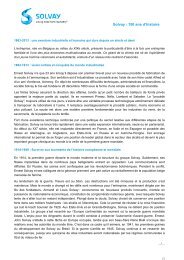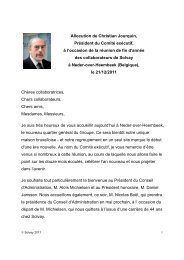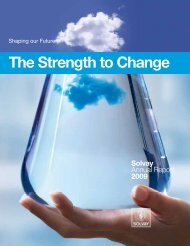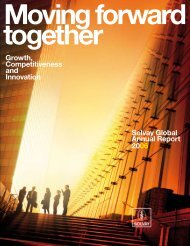solvay_live243_p02a04 somEdito
solvay_live243_p02a04 somEdito
solvay_live243_p02a04 somEdito
You also want an ePaper? Increase the reach of your titles
YUMPU automatically turns print PDFs into web optimized ePapers that Google loves.
Dossier SolvayInnovationTrophy2006<br />
60<br />
Ordinarily, tradition and innovation confront each<br />
other like sworn enemies.<br />
At Lafarge, the world’s number one construction<br />
materials group, they’ll freely admit that the sector<br />
used to be somewhat conservative, but they’re<br />
determined to move beyond this with a genuine<br />
strategy for progress. By thinking about people<br />
and their environment.<br />
Apriori, many powerful forces act as a brake on innovation.<br />
To mention just the two largest: force of habit<br />
amongst professional builders and the low turnover of<br />
customers, which do little to encourage suppliers to adopt<br />
new ways of working. Despite all this, the Lafarge group has decided<br />
to press ahead, against the current, and to provide customers<br />
with greater value. And its research budget, whilst low compared<br />
with other sectors, is above that of its competitors. A major component,<br />
moreover, is a change of mindset, which in principle costs<br />
nothing. Like when, faced with a problem of foaming during plaster<br />
production, Lafarge people went to Danone to see how it stabilizes<br />
its chocolate mousse.<br />
Progress by breaking with the past<br />
This proactive approach is enabling Lafarge to bring to market<br />
resolutely new products, which break with existing solutions.<br />
Corporate policy is to move beyond the incremental progress<br />
often linked to process research, with innovative products deriving<br />
directly from pure research.<br />
This policy is producing really amazing results. For example,<br />
Lafarge is right now testing concretes which remain very fluid<br />
for two hours and then set so fast that the formwork can be<br />
removed after four hours. It also produces 400 m 2 slabs without<br />
joints or cracks, which reduces maintenance costs 16-fold.<br />
It has also succeeded in producing plasterboards with four<br />
rounded edges, permitting for the first time the perfect finishing<br />
of plasterboard walls.<br />
It is important to state that Lafarge’s good technical and commercial<br />
results are the outcome of the group’s desire to speed up<br />
progress, expressed in a series of very concrete programmes.<br />
This is a complex process embracing both sales and research.<br />
Product application:<br />
the Spinnaker Tower (U.K.).<br />
Far beyond legal oblig<br />
As Lafarge people are quick to remind you, the success of an innovation<br />
lies not in the product itself, but the ability to deploy it<br />
and make it a success (1) .<br />
Sustainable citizenship<br />
Although this is not easy, Lafarge tries to have as strong an environmental<br />
and citizenship policy as possible. At times this lies in the<br />
novelty of its products. For example in a range of self-placing concretes,<br />
which do not need to be “vibrated” into place, and which<br />
offer the cumulative benefits of better filling quality, better productivity<br />
and reduced noise nuisance. Or again dust-free cements<br />
which provide workers with healthier working conditions. In most<br />
cases this policy is the fruit of the house philosophy - far from new<br />
- which takes a pro-active stance in an industry that, by definition,<br />
leaves a real imprint on our world. Like on landscapes: extracting<br />
450 million tonnes a year from more than 1 000 quarries necessarily<br />
leaves traces. Quarries are rehabilitated under plans which go<br />
much further than legal requirements. Better still, Lafarge has<br />
turned an obligation into a strategic direction: its soil remediation<br />
programme at its own sites serves as an example to others. When<br />
new operating permits are requested, decision-making authorities<br />
and pressure groups are invited to an already rehabilitated site,<br />
which becomes a visiting card. “If you’re not at the top, you’re<br />
nowhere”, they say at Lafarge. This logic has been pushed as far as<br />
producing meticulous biodiversity indexes (in conjunction with<br />
WWF International), with a commitment to replicate these on quitting<br />
the site. And last, but far from least, Lafarge applies its ethics


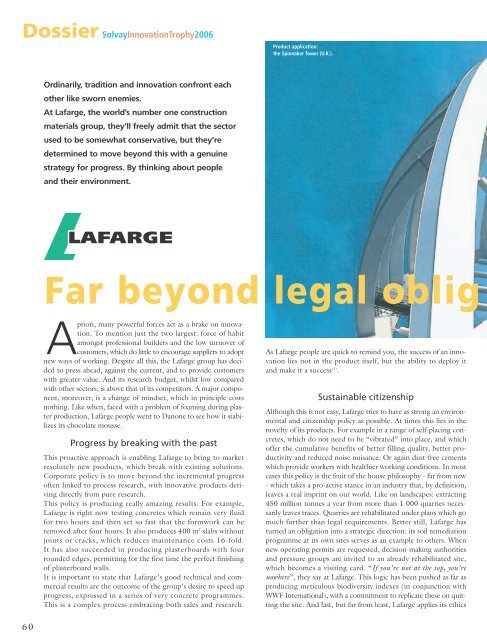
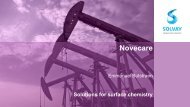
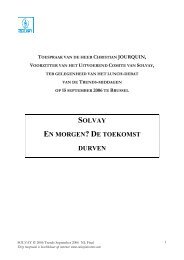
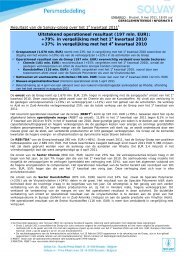

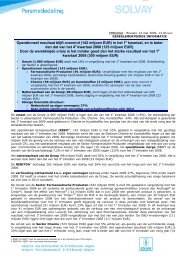
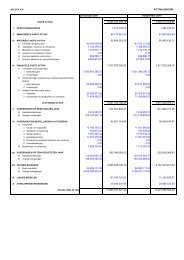

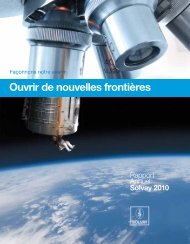
![PROC.1 [LETTRE] - Solvay](https://img.yumpu.com/16585746/1/184x260/proc1-lettre-solvay.jpg?quality=85)
